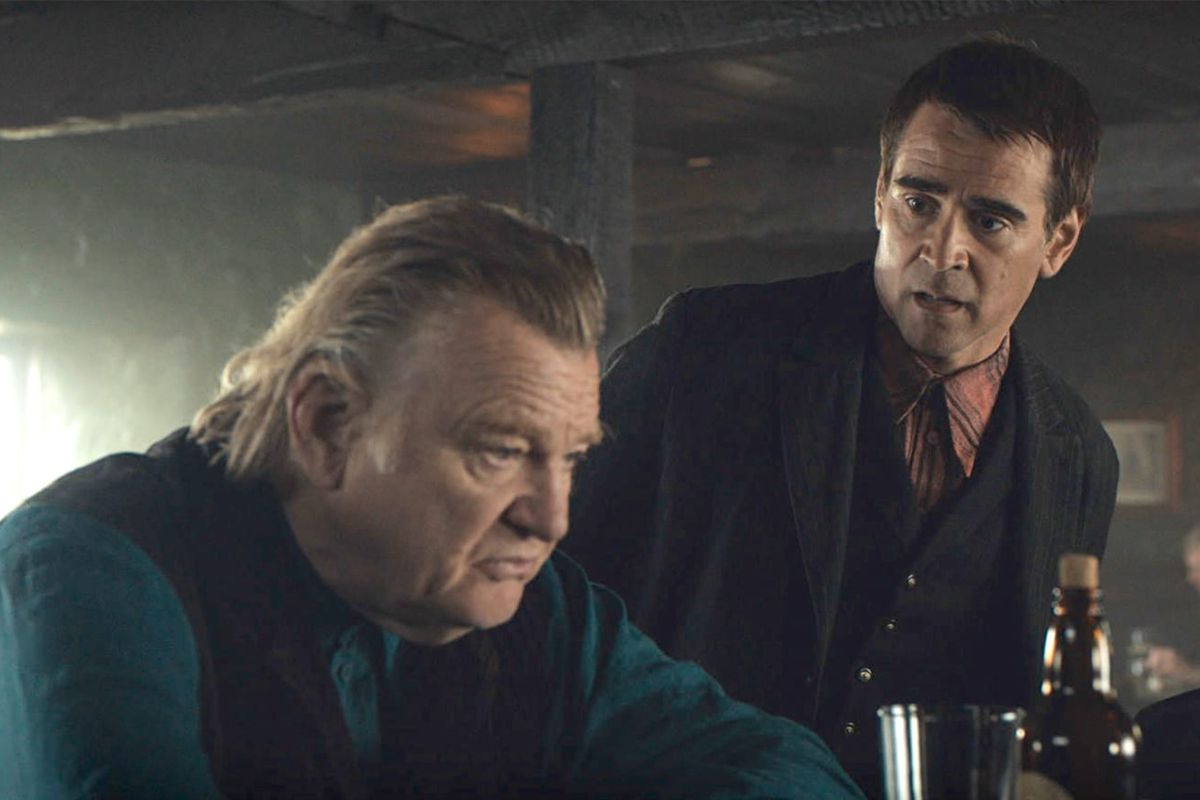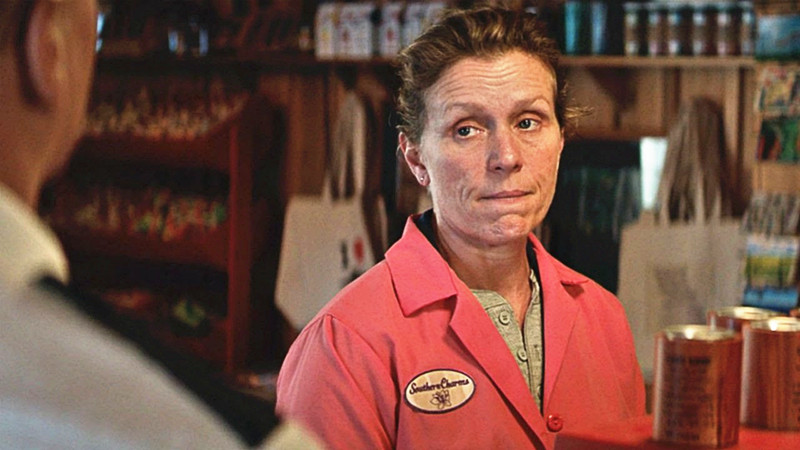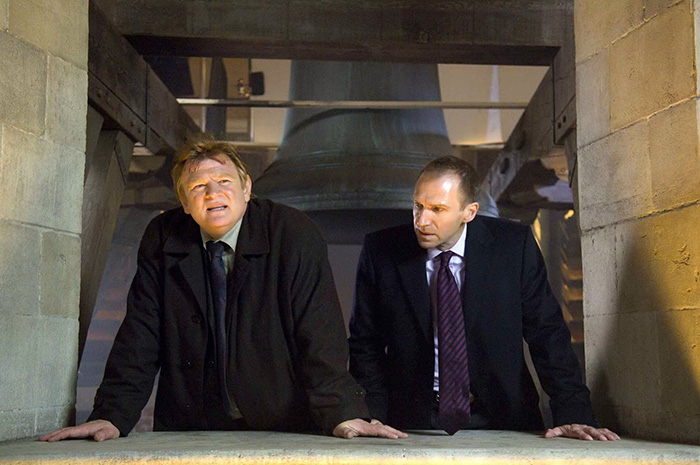3. The Banshees of Inisherin (2022)

The story takes place in 1923, during the Irish civil war. Set on the fictional island of Inisherin, off Ireland’s west coast, it sees the reunion of In Bruges alumnus Colin Farrell and Brendan Gleeson. Fiddle player Colm Doherty (Gleeson) informs his kind yet simple friend Pádraic Súilleabháin (Farrell) that he doesn’t want to be friends with him anymore. Devastated, Pádraic desperately attempts to reconcile with Colm. Colm delivers Pádraic an ultimatum: each time Pádraic talks to him from now on, Colm will cut-off one of his fingers.
The film’s dialogue is laugh-out-loud funny, in concurrence with its undertone of existential tragedy. Ben Davis’s symbolist cinematography marks a step-up in aesthetic merit from McDonagh’s previous releases. Unsurprisingly, the double act Gleeson and Farrell are once again at the top of their game: their performances as funny as they are skilful and humane. The mise-en-scène’s crammed with a wealth of intricate details: from the regional Gibson chairs to the red postbox being repainted green – symbolising Ireland’s emancipation from the British Empire.
Kerry Condon, first entering McDonagh’s cinematic world in Three Billboards, delivers a heart-wrenching, career-best performance as Siobhán. Though boasting many of the films funniest lines, Siobhán serves as a vessel for loneliness, making her an easy character to like and empathise with. Every person has experienced a variation of her despairing tears and Pádraic’s alienation. Crucially, Barry Keoghan and Gary Lydon sensitively deal with the psychological damage caused by pedophilia, a testament to their acting proficiency. Pat Short’s performance as the barman also stands-out. McDonagh has a talent for making his audiences love his flawed characters. It’s as if they become extensions of oneself, such is their universality.
Despite Banshees being an exceptional film, in it, there exists a puzzling plot element. When Colm informs Pádraic he no longer wants to speak to him, he very clearly states that he is doing this because he needs to focus on his fiddle-playing. He’s determined to leave a legacy of songs behind before he dies. He says it with such fervour and is shown to be so devoted to his musicianship, audiences understand that Colm is a man who lives for fiddle-playing – it means everything to him. Then, when Pádraic simply tries to reconcile with him, Colm cuts-off all of his fingers on his fiddle-playing hand. He is no-longer able to do the thing he loves most in the world. The very reason he stopped talking to Pádraic was to focus on his fiddle-playing.
Is this cohesive with the character to whom the audience was introduced? What details is McDonagh not sharing with us? Would a devoted musician like Colm ruin his greatest passion, ostensibly his only source of income on a remote island? Why would he destroy his vocation? Merely to prove a childish point to a kind, well-meaning man? To what end? Does he desire to ruin his ambition? Is he trying to destroy himself – is that the point? If he’s increasingly more afraid of death, as he expresses to Pádraic, then why is he sabotaging his remaining years? It’s plausible in a character of Colm’s depressive complexity, yet it feels forced and plays like an error. Perhaps McDonagh was writing an autobiographical story, but felt it needed to be more exciting. So, he injected it with a Grimm’s fairytale trope. Can Colm’s out-of-the-blue finger code coexist alongside his musical piety? Are these overreactions congruent with the truth of his character?
2. Three Billboards Outside Ebbing, Missouri (2017)

7 months after her daughter is raped, murdered and incinerated, Mildred Hayes (Frances McDormand) rents three roadside billboards, in order to highlight local police chief Bill Willoughby’s (Woody Harrelson) lack of effort in solving the case. Meanwhile, racist cop Jason Dixon (Sam Rockwell) makes a power-drunk rampage in her hometown of Ebbing, Missouri.
The scene where Mildred’s ex-husband, Charlie (John Hawkes), bursts into her house, rowing, remains one of the best-written and best-acted scenes in cinema history. It is the zenith of drama, a volcano of McDonagh’s finest work in theatre and film. The scene serves is a crucible for the marital and familial tensions present in households across the globe and shows the tenderness underneath even the most violent of people. John Hawkes, who, for years has enhanced productions with his character work, is deservedly given the opportunity to be the forefront of the audience’s attention.
What holds the moving Three Billboards back slightly is Abbie Cornish’s cringeworthy acting, paling in comparison to heavyweights like Frances McDormand and Woody Harrelson. True to form, McDormand’s performance is mesmerising, sagacious, passionate and flawless. It is apparent why she and Rockwell won Academy Awards for their work in this film. Furthermore, Harrelson demonstrates that he is as adroit a serious dramatic actor as he is a superlative crime movie tough guy and comedian. Aside from loveable turns by Kerry Condon and Caleb Landry Jones, Game of Thrones star Peter Dinklage excels as the humble James, expressing the sensitivity in all of us.
Upon its release, some audience members took issue with Three Billboards’ perceived redemption story of a racist. They felt that an individual who perpetrates racial violence should not have been depicted in a remotely sympathetic light (Rockwell as Dixon). On this controversy, McDonagh commented: “I don’t think [Rockwell’s] character is redeemed at-all. But by the end, he’s seen that he has to change. But in no way is he supposed to become some kind of redeemed hero.” Darrell Britt-Gibson (who played Jerome) added: “In life, you don’t go from A to Z. You go from A to A.5. I think, at the end of the film, Dixon is at his A.5.”
Touched by the forgiveness of Welby (Landry Jones), Dixon begins to recognise the goodness in himself and others. He is not as two-dimensional as a mere racist. McDonagh paints him with rare glimmers of courageousness, underlining the complexity of people in reality. The writing suggests Dixon had positive qualities in him all-along, but they grew increasingly more masked by learned hate. It is this glimmer of hope Dixon sees in himself that is the true take-away of the film. When we open ourselves up to empathy, it is possible for us to evolve into more compassionate, intelligent people. But the audience never does see whether Dixon ‘changes his ways’ – it could go either way for him. “Anger begets greater anger,” McDonagh writes.
1. In Bruges (2008)

Colin Farrell and Brendan Gleeson deliver the best performances of their careers, as Irish hitmen Ray and Ken. The friends are dispatched by their boss, Harry (Ralph Fiennes), to the Belgian city of Bruges to hide-out. The older Ken is intrigued by the city’s history and enjoys sightseeing, while the younger Ray despises the place. Soon, Ray’s chequered past in London closes-in on the odd couple from across the English Channel. Harold Pinter’s play The Dumbwaiter served as inspiration for McDonagh’s first feature.
Imperatively, In Bruges is a sidesplitting black comedy. This tragi-comic mood is best encapsulated in the iconic “Chinese lollipop man” scene. Undoubtedly one of the best comedies and crime films ever made, it is the paragon of Dublin humour. McDonagh was arguably the first director to utilise Colin Farrell’s comedic genius. Even this early-on in his career, Farrell’s talent is startling. He’s mastered both drama and comedy in the space of one film. Furthermore, as put by Roger Ebert, the masterful Gleeson could endear a viewer to even the most reprehensible of characters. He seamlessly warms audiences with Ken’s culture, dignity and integrity.
One of In Bruges’ funniest elements is Ray’s (Farrell) all-consuming obsession with little people. A reason the film has remained beloved is the humour is not derived from making fun of those with achondroplasia. Instead, the laughter sprouts from Ray’s eccentric, never-ending adoration of little people, not they themselves. Ray rattles on and on about them to everyone he meets, especially when he’s flirting with Chlöe (Clémence Poésy). When Ray meets a little person, ketamine-addled actor Jimmy (Jordan Prentice), he is palpably ecstatic: all his dreams have come true. Even after he’s been shot, Ray’s still nattering about little people.
In essence, In Bruges is a stunningly-acted, relatable exploration of guilt, drawing on the imagery of Hieronymus Bosch. It contains the multisided humanism you’d expect from a writer of McDonagh’s preeminence. At-heart, it asks: if someone does a terrible thing, can they ever be forgiven? Can they forgive themselves? Will they let guilt destroy them from the inside, ruining their lives, or is there a way to overcome it? What constitutes redemption? Should we allow others a second chance, even if they’ve committed atrocious acts? Is anyone truly good or bad, or are we all yin and yang? What determines how we judge others? What awaits us in death – an afterlife?
The magnum opus that is In Bruges has only one flaw. Though a superb actor, Ralph Fiennes, to Londoners’ ears at-least, does not consistently deliver a convincing cockney accent. Given, throughout the majority of his scenes, Fiennes does just manage to successfully parrot the dialect. However, at crucial moments, he lets it slip: revealing his true upper-middle class accent. This destroys the illusion that Harry could plausibly be an East End mobster. It may be less detectable to audiences outside the UK, but to attuned British ears, it is substandard, signalling a blunder on casting director Jina Jay’s part. In retrospect, Harry should’ve been embodied by an actual cockney actor, if believability was McDonagh’s aim. Ray Winstone or Alan Ford would have excelled in the part. Nevertheless, overall, this detail does not detract from a nearly perfect film.